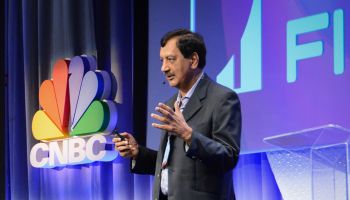“I want to be part of the solution”
Banker Jay Sidhu on why he’s shifting gears
- |
- Written by Steve Cocheo

For a moment, it was hard to tell if this was a session of the Exponential Finance conference or a meeting of “Bankers Anonymous.”
“I used to be addicted to these fees,” veteran banker Jay Sidhu told his audience. “I decided, never, ever again. I want to be part of the solution now.”
Perhaps this was as much a change of business strategy and concentration as a change of heart, though many commentators at Exponential Finance criticized banks for their longtime dependence on fees such as overdraft charges. Exponential Finance is sponsored by Singularity University, CNBC, and Deloitte.
Before making his declaration, Sidhu, chairman and CEO of $7.1 billion-assets Customers Bancorp, Inc., had been reeling off statistics about consumer fees charged by banks. This included statements that:
• 68 million Americans are unbanked or underbanked.
• Banks charge $32 billion annually in overdraft fees, which he said meant “allowing or creating over 1 billion overdrafts each year.”
• Those charges, plus $7 billion charged by payday lenders in fees, total to more than three times what America spends on breast cancer and lung cancer combined.
“Why are we doing this?” said Sidhu. “This should not be happening in America.”
“Disruption of banking is bound to happen,” Sidhu exclaimed. “It is happening right now!”
Sidhu poked fun at some banking industry notions of innovation, in light of where technology is now. He laughed at one competitor’s “branches of the future,” complete with plasma screens.
“Everyone carries a screen in their pocket now,” said Sidhu. “So why is putting a screen in a branch building ‘innovative’ ?” He said branches with no more innovation than that weren’t branches of the future, but rather, “branches of the 1960s.”
Sidhu believes the banking industry has failed to adapt to new concepts of “community,” as well. Banks still see the term as a geographical one, he said, while he believes that “communities are digital—that happened ten years ago.”
Sidhu’s BankMobile launches
Sidhu’s conference theme was “Delivering the Uber-like Experience in Consumer Banking.” His Customers Bancorp, Inc., operates a regional “branch-lite” network of branches and other offices from Boston to Philadelphia. In early 2015 its BankMobile division launched the first phase of its business plan. Sidhu has characterized BankMobile as “a new revolution” to profitably solve the fee inequities he cited earlier, with an accent on convenience.
“Banking is not really about products,” said Sidhu. “You are really selling an experience.” He compared banks that don’t understand that wrinkle to Kodak, which saw itself as selling film, when what people wanted was an easy way to take and share pictures.
BankMobile is a branchless bank offering a no-fee, mobile, online, and tablet banking platform. The new operation, founded last year, specifically targets its products and services to millennials, middle-class families, and underserved and underbanked consumers. Available services include no-fee ATMs, a line of credit, and 25 bps higher interest on savings. Bank officials have told investors that they hope to retain at least 25% of approximately 1 million student customers over a five-year period.
Sidhu anticipates holding the parent company’s investment to about $6 million by the end of this year. He anticipates reaching profitability in the division within two to three years. Revenue would be built on debit card interchange and margin from low-cost deposits. (Financial details come from an investor presentation by Customers Bank conducted just prior to the conference.)
Sidhu believes efficiency and convenience will help bring in customers for BankMobile. “Why shouldn’t you be able to open an account on a smartphone in minutes?” said Sidhu. He told listeners that BankMobile accounts are growing by 60% a month.
“You don’t need a bank charter” to accomplish such goals, according to Sidhu, “but I’ll tell you if you have a bank charter it’s a lot better.”
Sidhu believes that the metrics of the banking industry will be changing as the banking value proposition evolves.
“I think the valuation of banks will change,” said Sidhu. “Banks will be compared on the basis of the number of customer relationships they have, not on their deposits.”
Glimpse of future structure
After his presentation, Sidhu joined a small panel discussion group. Banking futurist Brett King, also founder and head of Moven, a consumer banking application powered underneath by a bank partner in the U.S. and more explicitly in Canada, was his discussion partner.
King noted that typically disruptive startups, like his own, still require a banking industry interface to function. What sets them apart from more traditional players is that they don’t try to be all things to all customers.
“They take one experience,” said King, “and they do it really well. They don’t want to be a universal bank.”
Sidhu agreed, but from a different viewpoint. “The Ubers and the Amazons don’t want to have a bank charter,” said Sidhu. “They don’t want to be regulated.”
Long term, King said, he expects the largest banks to find it most difficult to transition into an era disrupted by fintech players. He sees the industry splitting into a mix of firms providing the “experience layer”—where service meets customers—and other providers who will be wholesalers, who will provide the engine behind the service.
Sidhu believes that from today’s 6,000-odd financial institutions, the industry will shrink to about 1,000 smaller banks and 10-15 large banks.
“The larger you are,” said Sidhu, “the tougher it will be to change.”
Another question concerned the future of cash in consumer banking.
King predicted that the U.S. would be cashless by 2030, but Sidhu sees the country entering this stage much sooner. He believes this could be only five or six years away.
Tagged under Customers, Retail Banking, Management, Lines of Business, Feature, Feature3,













